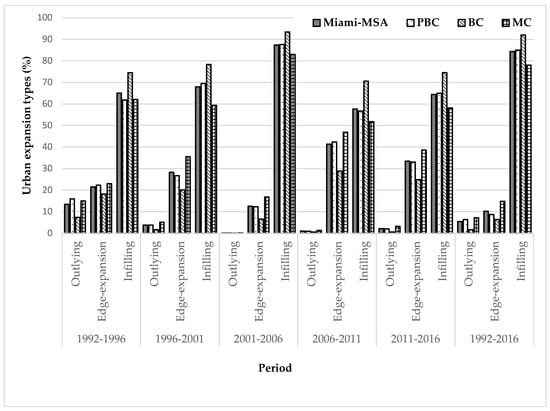Quantifying Spatiotemporal Patterns and Major Explanatory Factors of Urban Expansion in Miami Metropolitan Area During 1992–2016
Abstract
:1. Introduction
2. Materials and Methods
2.1. Study Area
2.2. Data
2.2.1. LULC Data
2.2.2. Major Explanatory Factors of Urban Expansion
2.3. Methods
2.3.1. Annual Urban Expansion Rate
2.3.2. Annual Expansion Type
2.3.3. Urban Expansion Intensity
2.3.4. Landscape Metrics
2.3.5. Urban Expansion Direction
2.3.6. Factors Influencing Urban Area
Correlation Analysis
Regression Analysis
3. Results
3.1. Urban Expansion Rate
3.2. Urban Expansion Types
3.3. Urban Expansion Intensity Index
3.4. Landscape Metrics
3.5. Urban Expansion Direction
3.6. Statistical Analyses
4. Discussion
4.1. Spatiotemporal Patterns of Urban Expansion
4.2. Major Explanatory Factors of Urban Expansion
4.3. Limitations of the Study and Future Work
5. Conclusions
Author Contributions
Funding
Acknowledgments
Conflicts of Interest
Appendix A
| Urban Area | Non-Urban Area | |||||||||||
|---|---|---|---|---|---|---|---|---|---|---|---|---|
| 1992 | 1996 | 2001 | 2006 | 2011 | 2016 | 1992 | 1996 | 2001 | 2006 | 2011 | 2016 | |
| Miami-MSA | 2308.28 | 2491.09 | 2973.93 | 3065.99 | 3110.55 | 3167.78 | 11848.94 | 11666.13 | 11183.29 | 11091.23 | 11046.67 | 10989.97 |
| PBC | 780.01 | 874.58 | 1116.52 | 1145.85 | 1163.67 | 1183.77 | 4982.09 | 4887.52 | 4645.58 | 4616.25 | 4598.43 | 4578.33 |
| BC | 699.60 | 748.83 | 885.22 | 906.26 | 917.99 | 926.6 | 2470.23 | 2421.0 | 2284.61 | 2263.57 | 2251.84 | 2243.23 |
| MC | 828.67 | 867.19 | 971.3 | 1013.0 | 1027.8 | 1054.69 | 4396.62 | 4358.1 | 4253.99 | 4212.29 | 4197.49 | 4170.6 |
References
- United Nations. World Urbanization Prospects, the 2018 Revision; United Nations: New York, NY, USA, 2018; Available online: http://esa.un.org/unpd/wup/index.htm 2018 (accessed on 13 July 2019).
- Neumann, B.; Vafeidis, A.T.; Zimmermann, J.; Nicholls, R.J. Future Coastal Population Growth and Exposure to Sea-Level Rise and Coastal Flooding—A Global Assessment. PLoS ONE 2015, 10, e0118571. [Google Scholar] [CrossRef] [PubMed]
- Zhao, S.; Zhou, D.; Zhu, C.; Qu, W.; Zhao, J.; Sun, Y.; Huang, D.; Wu, W.; Liu, S. Rates and patterns of urban expansion in China’s 32 major cities over the past three decades. Landsc. Ecol. 2015, 30, 1541–1559. [Google Scholar] [CrossRef]
- Zhao, S.; Da, L.; Tang, Z.; Fang, H.; Song, K.; Fang, J. Ecological consequences of rapid urban expansion: Shanghai, China. Front. Ecol. Environ. 2006, 4, 341–346. [Google Scholar] [CrossRef]
- Shi, Y.; Li, S. Research on Rational Urban Growth and Land-Use Issues. J. Urban Plan. Dev. 2007, 133, 91–94. [Google Scholar] [CrossRef]
- Grimm, N.B.; Faeth, S.H.; Golubiewski, N.E.; Redman, C.L.; Wu, J.; Bai, X.; Briggs, J.M.; Grimm, N. Global Change and the Ecology of Cities. Science 2008, 319, 756–760. [Google Scholar] [CrossRef] [Green Version]
- Jenerette, G.D.; Potere, D. Global analysis and simulation of land-use change associated with urbanization. Landsc. Ecol. 2010, 25, 657–670. [Google Scholar] [CrossRef]
- Zheng, Z.; Bohong, Z. Study on Spatial Structure of Yangtze River Delta Urban Agglomeration and Its Effects on Urban and Rural Regions. J. Urban Plan. Dev. 2012, 138, 78–89. [Google Scholar] [CrossRef]
- Tan, M.; Li, X.; Xie, H.; Lu, C. Urban land expansion and arable land loss in China—A case study of Beijing–Tianjin–Hebei region. Land Use Policy 2005, 22, 187–196. [Google Scholar] [CrossRef]
- Radeloff, V.C.; Stewart, S.I.; Hawbaker, T.J.; Todd, J.; Gimmi, U.; Pidgeon, A.M.; Flather, C.H.; Hammer, R.B.; Helmers, D.P. Housing growth in and near United States protected areas limits their conservation value. Proc. Natl. Acad. Sci. USA 2010, 107, 940–945. [Google Scholar] [CrossRef]
- Folke, C.; Jansson, A.; Larsson, J.; Costanza, R. Ecosystem appropriation by cities. Ambio 1997, 26, 167–172. [Google Scholar]
- Jenerette, G.D.; Wu, J. Analysis and simulation of land-use change in the central Arizona—Phoenix region, USA. Landsc. Ecol. 2001, 16, 611–626. [Google Scholar] [CrossRef]
- Wu, J.; Jenerette, G.D.; Buyantuyev, A.; Redman, C.L. Quantifying spatiotemporal patterns of urbanization: The case of the two fastest growing metropolitan regions in the United States. Ecol. Complex. 2011, 8, 1–8. [Google Scholar] [CrossRef]
- Seto, K.C.; Gu¨neralp, B.; Hutyra, L.R. Global forecasts of urban expansion to 2030 and direct impacts on biodiversity and carbon pools. Proc. Natl. Acad. Sci. USA 2012, 109, 16083–16088. [Google Scholar] [CrossRef] [PubMed] [Green Version]
- He, C.; Liu, Z.; Tian, J.; Ma, Q. Urban expansion dynamics and natural habitat loss in China: A multiscale landscape perspective. Glob. Chang. Boil. 2014, 20, 2886–2902. [Google Scholar] [CrossRef] [PubMed]
- Shao, M.; Tang, X.; Zhang, Y.; Li, W. City clusters in China: Air and surface water pollution. Front. Ecol. Environ. 2006, 4, 353–361. [Google Scholar] [CrossRef]
- Chen, Y.; Zhang, Z.; Du, S.Q.; Shi, P.J.; Tao, F.L.; Doyle, M. Water quality changes in the world’s first special economic zone, Shenzhen, China. Water Resour. Res. 2011, 47. [Google Scholar] [CrossRef]
- Baker, L.A.; Hope, D.; Xu, Y.; Edmonds, J.; Lauver, L. Nitrogen Balance for the Central Arizona-Phoenix (CAP) Ecosystem. Ecosystems 2001, 4, 582–602. [Google Scholar] [CrossRef]
- Kaye, J.P.; Groffman, P.M.; Grimm, N.B.; Baker, L.A.; Pouyat, R.V. A distinct urban biogeochemistry? Trends Ecol. Evol. 2006, 21, 192–199. [Google Scholar] [CrossRef]
- Trusilova, K.; Jung, M.; Churkina, G.; Karstens, U.; Heimann, M.; Claussen, M. Urbanization Impacts on the Climate in Europe: Numerical Experiments by the PSU–NCAR Mesoscale Model (MM5). J. Appl. Meteorol. Clim. 2008, 47, 1442–1455. [Google Scholar] [CrossRef]
- Yang, X.; Hou, Y.; Chen, B. Observed surface warming induced by urbanization in east China. J. Geophys. Res. Atoms. 2011, 116, 116. [Google Scholar] [CrossRef]
- Walker, R. Urban sprawl and natural areas encroachment: Linking land cover change and economic development in the Florida Everglades. Ecol. Econ. 2001, 37, 357–369. [Google Scholar] [CrossRef]
- Jensen, J.R.; Cowen, D.C. Remote sensing of urban/suburban infrastructure and socio-economic attributes. Photogramm. Eng. Remote Sens. 1999, 65, 611–622. [Google Scholar]
- Herold, M.; Goldstein, N.C.; Clarke, K.C. The spatiotemporal form of urban growth: Measurement, analysis and modeling. Remote Sens. Environ. 2003, 86, 286–302. [Google Scholar] [CrossRef]
- Michishita, R.; Jiang, Z.; Xu, B. Monitoring two decades of urbanization in the Poyang Lake area, China through spectral unmixing. Remote Sens. Environ. 2012, 117, 3–18. [Google Scholar] [CrossRef]
- Sun, Y.; Zhao, S.; Qu, W. Quantifying spatiotemporal patterns of urban expansion in three capital cities in Northeast China over the past three decades using satellite data sets. Environ. Earth Sci. 2015, 73, 7221–7235. [Google Scholar] [CrossRef]
- Turner, M.G.; Gardner, R.H. Quantitative Methods in Landscape Ecology; Springer: New York, NY, USA, 1991. [Google Scholar]
- McGarigal, K.; Marks, B.J. FRAGSTATS: Spatial Pattern Analysis Program for Quantifying Landscape Structure; USDA Forest Service: Washington, DC, USA, 1995; Volume 351. [Google Scholar]
- Sudhira, H.; Ramachandra, T.; Jagadish, K. Urban sprawl: Metrics, dynamics and modelling using GIS. Int. J. Appl. Earth Obs. Geoinf. 2004, 5, 29–39. [Google Scholar] [CrossRef]
- Xu, C.; Liu, M.; Zhang, C.; An, S.; Yu, W.; Chen, J.M. The spatiotemporal dynamics of rapid urban growth in the Nanjing metropolitan region of China. Landsc. Ecol. 2007, 22, 925–937. [Google Scholar] [CrossRef]
- Zhao, J.; Zhu, C.; Zhao, S. Comparing the Spatiotemporal Dynamics of Urbanization in Moderately Developed Chinese Cities over the Past Three Decades: Case of Nanjing and Xi’an. J. Urban Plan. Dev. 2015, 141, 5014029. [Google Scholar] [CrossRef]
- Zhao, S.; Zhou, D.; Zhu, C.; Sun, Y.; Wu, W.; Liu, S. Spatial and Temporal Dimensions of Urban Expansion in China. Environ. Sci. Technol. 2015, 49, 9600–9609. [Google Scholar] [CrossRef]
- Ramachandra, T.V.; Aithal, B.H.; Sanna, D.D. Insights to urban dynamics through landscape spatial pattern analysis. Int. J. Appl. Earth Obs. Geoinf. 2012, 18, 329–343. [Google Scholar]
- Li, Q.; Lu, L.; Weng, Q.; Xie, Y.; Guo, H. Monitoring Urban Dynamics in the Southeast U.S.A. Using Time-Series DMSP/OLS Nightlight Imagery. Remote Sens. 2016, 8, 578. [Google Scholar] [CrossRef]
- Shi, G.; Jiang, N.; Li, Y.; He, B. Analysis of the Dynamic Urban Expansion Based on Multi-Sourced Data from 1998 to 2013: A Case Study of Jiangsu Province. Sustainability 2018, 10, 3467. [Google Scholar] [CrossRef]
- Chen, L.; Ren, C.; Zhang, B.; Wang, Z.; Liu, M. Quantifying Urban Land Sprawl and its Driving Forces in Northeast China from 1990 to 2015. Sustainability 2018, 10, 188. [Google Scholar] [CrossRef]
- Yu, W.; Zhou, W. The Spatiotemporal Pattern of Urban Expansion in China: A Comparison Study of Three Urban Megaregions. Remote Sens. 2017, 9, 45. [Google Scholar] [CrossRef]
- Hu, Y.; Jia, G.; Pohl, C.; Feng, Q.; He, Y.; Gao, H.; Xu, R.; Van Genderen, J.; Feng, J. Improved monitoring of urbanization processes in China for regional climate impact assessment. Environ. Earth Sci. 2015, 73, 8387–8404. [Google Scholar] [CrossRef]
- Yang, Y.Y.; Zhang, S.W.; Yang, J.C.; Xing, X.S.; Wang, D.Y. Using a cellular automata-markov model to reconstruct spatial land-use patterns in Zhenlai County, Northeast China. Energies 2015, 8, 3882–3902. [Google Scholar] [CrossRef]
- Li, X.M.; Zhou, W.Q.; Ouyang, Z.Y. Forty years of urban expansion in Beijing: What is the relative importance of physical, socioeconomic, and neighborhood factors? Appl. Geogr. 2013, 38, 1–10. [Google Scholar] [CrossRef]
- Tian, G.; Qiao, Z.; Zhang, Y. The investigation of relationship between rural settlement density, size, spatial distribution and its geophysical parameters of China using Landsat TM images. Ecol. Model. 2012, 231, 25–36. [Google Scholar] [CrossRef]
- Luo, J.; Wei, Y.D. Modeling spatial variations of urban growth patterns in Chinese cities: The case of Nanjing. Landsc. Urban Plan. 2009, 91, 51–64. [Google Scholar] [CrossRef]
- Aspinall, R. Modelling land use change with generalized linear models—A multi-model analysis of change between 1860 and 2000 in Gallatin Valley, Montana. J. Environ. Manag. 2004, 72, 91–103. [Google Scholar] [CrossRef]
- Ye, Y.; Zhang, H.; Liu, K.; Wu, Q. Research on the influence of site factors on the expansion of construction land in the Pearl River Delta, China: By using GIS and remote sensing. Int. J. Appl. Earth Obs. Geoinf. 2013, 21, 366–373. [Google Scholar] [CrossRef]
- Vermeiren, K.; Van Rompaey, A.; Loopmans, M.; Serwajja, E.; Mukwaya, P. Urban growth of Kampala, Uganda: Pattern analysis and scenario development. Landsc. Urban Plan. 2012, 106, 199–206. [Google Scholar] [CrossRef]
- Li, G.; Sun, S.; Fang, C. The varying driving forces of urban expansion in China: Insights from a spatial-temporal analysis. Landsc. Urban Plan. 2018, 174, 63–77. [Google Scholar] [CrossRef]
- Vogelmann, J.E.; Howard, S.M.; Yang, L.; Larson, C.R.; Wylie, B.K.; Van Driel, N. Completion of the 1990s National Land Cover Data Set for the Conterminous United States from Landsat Thematic Mapper data and ancillary data sources. Photogramm. Eng. Remote Sens. 2001, 67, 650–662. [Google Scholar]
- Homer, C.; Dewitz, J.; Fry, J.; Coan, M.; Hossain, N.; Larson, C.; Herold, N.; McKerrow, A.; Van Driel, J.N.; Wickham, J.D. Completion of the 2001 National Land Cover Database for the conterminous United States. Photogramm. Eng. Remote Sens. 2007, 73, 337–341. [Google Scholar]
- Mitsova, D.; Shuster, W.; Wang, X. A cellular automata model of land cover change to integrate urban growth with open space conservation. Landsc. Urban Plan. 2011, 99, 141–153. [Google Scholar] [CrossRef]
- Yang, L.; Jin, S.; Danielson, P.; Homer, C.; Gass, L.; Bender, S.M.; Case, A.; Costello, C.; Dewitz, J.; Fry, J.; et al. A new generation of the United States National Land Cover Database: Requirements, research priorities, design, and implementation strategies. ISPRS J. Photogramm. Remote Sens. 2018, 146, 108–123. [Google Scholar] [CrossRef]
- Wickham, J.; Stehman, S.V.; Gass, L.; Dewitz, J.A.; Sorenson, D.G.; Granneman, B.J.; Poss, R.V.; Baer, L.A. Thematic accuracy assessment of the 2011 National Land Cover Database (NLCD). Remote Sens. Environ. 2017, 191, 328–341. [Google Scholar] [CrossRef] [Green Version]
- Wickham, J.; Stehman, S.V.; Gass, L.; Dewitz, J.; Fry, J.A.; Wade, T.G. Accuracy assessment of NLCD 2006 land cover and impervious surface. Remote Sens. Environ. 2013, 130, 294–304. [Google Scholar] [CrossRef]
- Wickham, J.; Stehman, S.; Fry, J.; Smith, J.; Homer, C. Thematic accuracy of the NLCD 2001 land cover for the conterminous United States. Remote Sens. Environ. 2010, 114, 1286–1296. [Google Scholar] [CrossRef]
- Stehman, S.V.; Wickham, J.D.; Smith, J.H.; Yang, L. Thematic accuracy of the 1992 National Land Cover Data (NLCD) for the eastern United States: Statistical methodology and regional results. Remote Sens. Environ. 2003, 86, 500–516. [Google Scholar] [CrossRef]
- Coastal Change Analysis Program (C-CAP) Regional Land Cover. Available online: https://coast.noaa.gov/data/digitalcoast/pdf/ccap-faq-regional.pdf (accessed on 13 October 2019).
- Manson, S.; Schroeder, J.; Van Riper, D.; Ruggles, S. IPUMS National Historical Geographic Information System: Version 14.0 [Database]; IPUMS: Minneapolis, MN, USA, 2019. [Google Scholar] [CrossRef]
- Fang, C.; Li, G.; Wang, S. Changing and Differentiated Urban Landscape in China: Spatiotemporal Patterns and Driving Forces. Environ. Sci. Technol. 2016, 50, 2217–2227. [Google Scholar] [CrossRef] [PubMed]
- Hair, J.F., Jr.; Black, W.C.; Babin, B.J.; Anderson, R.E. Multivariate Data Analysis, 7th ed.; Pearson: New York, NY, USA, 2010; pp. 151–230. [Google Scholar]
- Hossain, M.K.; Meng, Q. A thematic mapping method to assess and analyze potential urban hazards and risks caused by flooding. Comput. Environ. Urban Syst. 2020, 79, 101417. [Google Scholar] [CrossRef]
- Güneralp, B.; Seto, K.C. Futures of global urban expansion: Uncertainties and implications for biodiversity conservation. Environ. Res. Lett. 2013, 8, 014025. [Google Scholar] [CrossRef]
- Li, L.; Lu, D.; Kuang, W. Examining Urban Impervious Surface Distribution and Its Dynamic Change in Hangzhou Metropolis. Remote Sens. 2016, 8, 265. [Google Scholar] [CrossRef]
- Dou, Y.; Liu, Z.; He, C.; Yue, H. Urban Land Extraction Using VIIRS Nighttime Light Data: An Evaluation of Three Popular Methods. Remote Sens. 2017, 9, 175. [Google Scholar] [CrossRef]
- Zhang, W.; Li, W.; Zhang, C.; Ouimet, W.B. Detecting horizontal and vertical urban growth from medium resolution imagery and its relationships with major socioeconomic factors. Int. J. Remote Sens. 2017, 38, 3704–3734. [Google Scholar] [CrossRef]
- Handayani, H.H.; Murayama, Y.; Ranagalage, M.; Liu, F.; Dissanayake, D. Geospatial Analysis of Horizontal and Vertical Urban Expansion Using Multi-Spatial Resolution Data: A Case Study of Surabaya, Indonesia. Remote Sens. 2018, 10, 1599. [Google Scholar] [CrossRef]


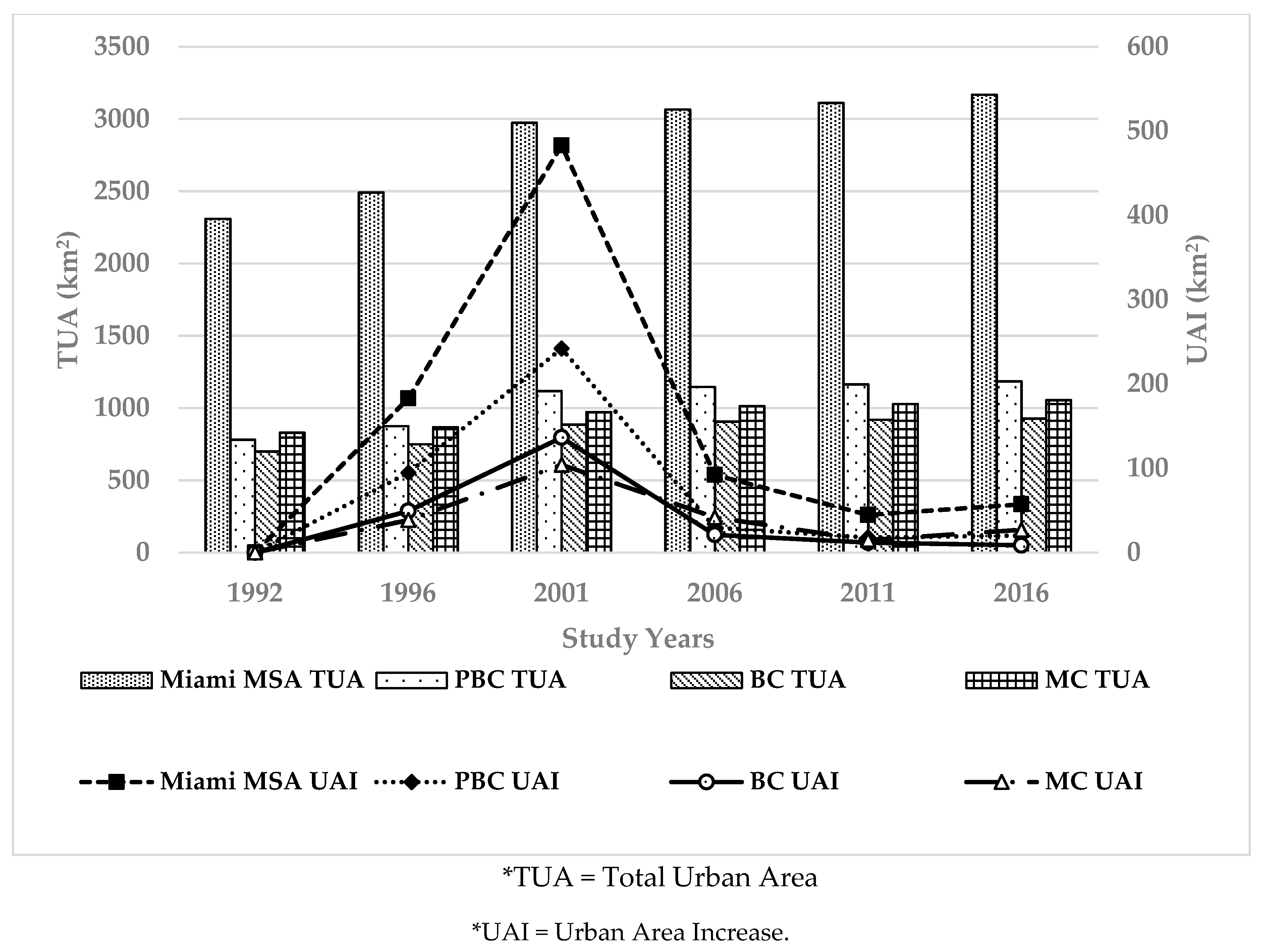

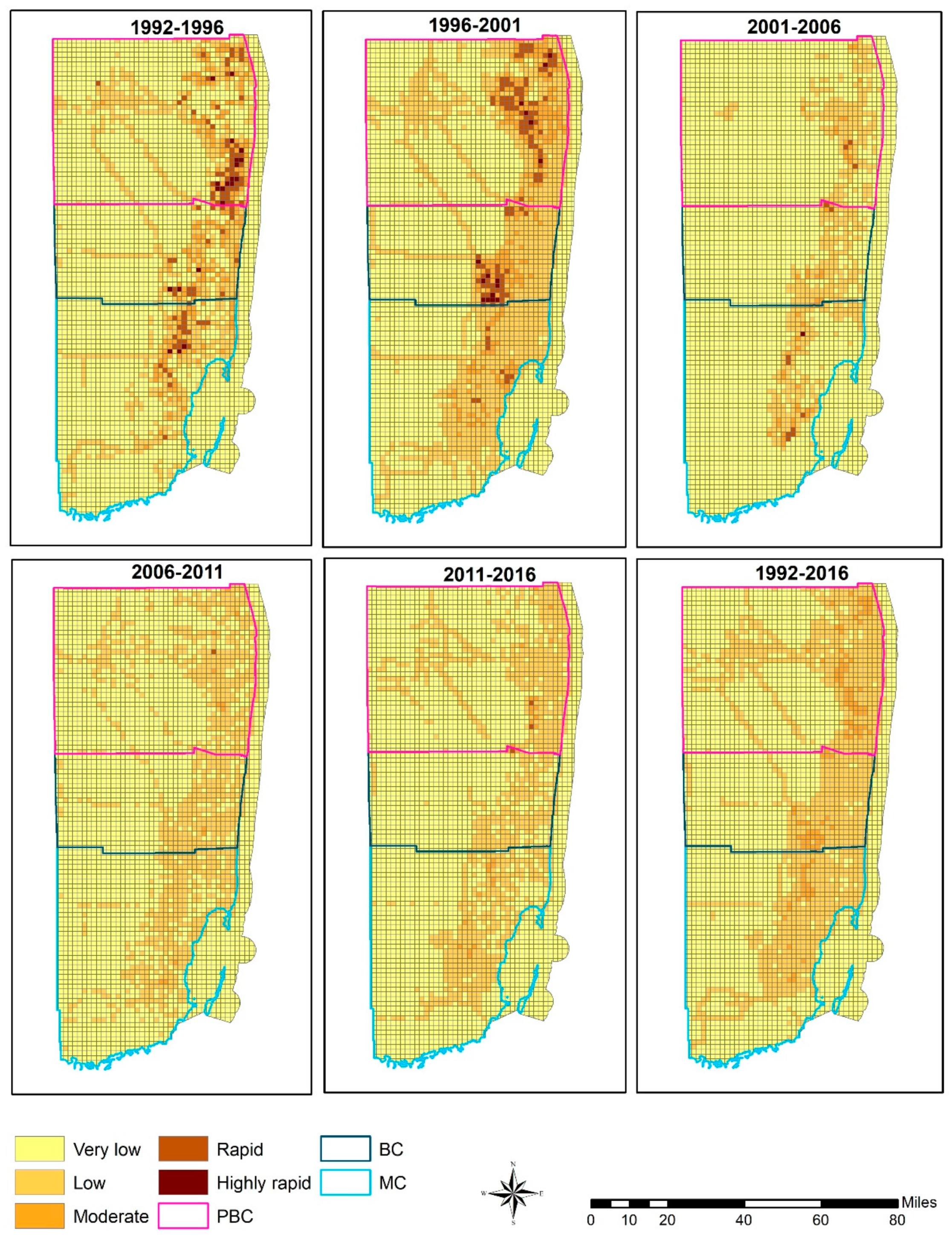
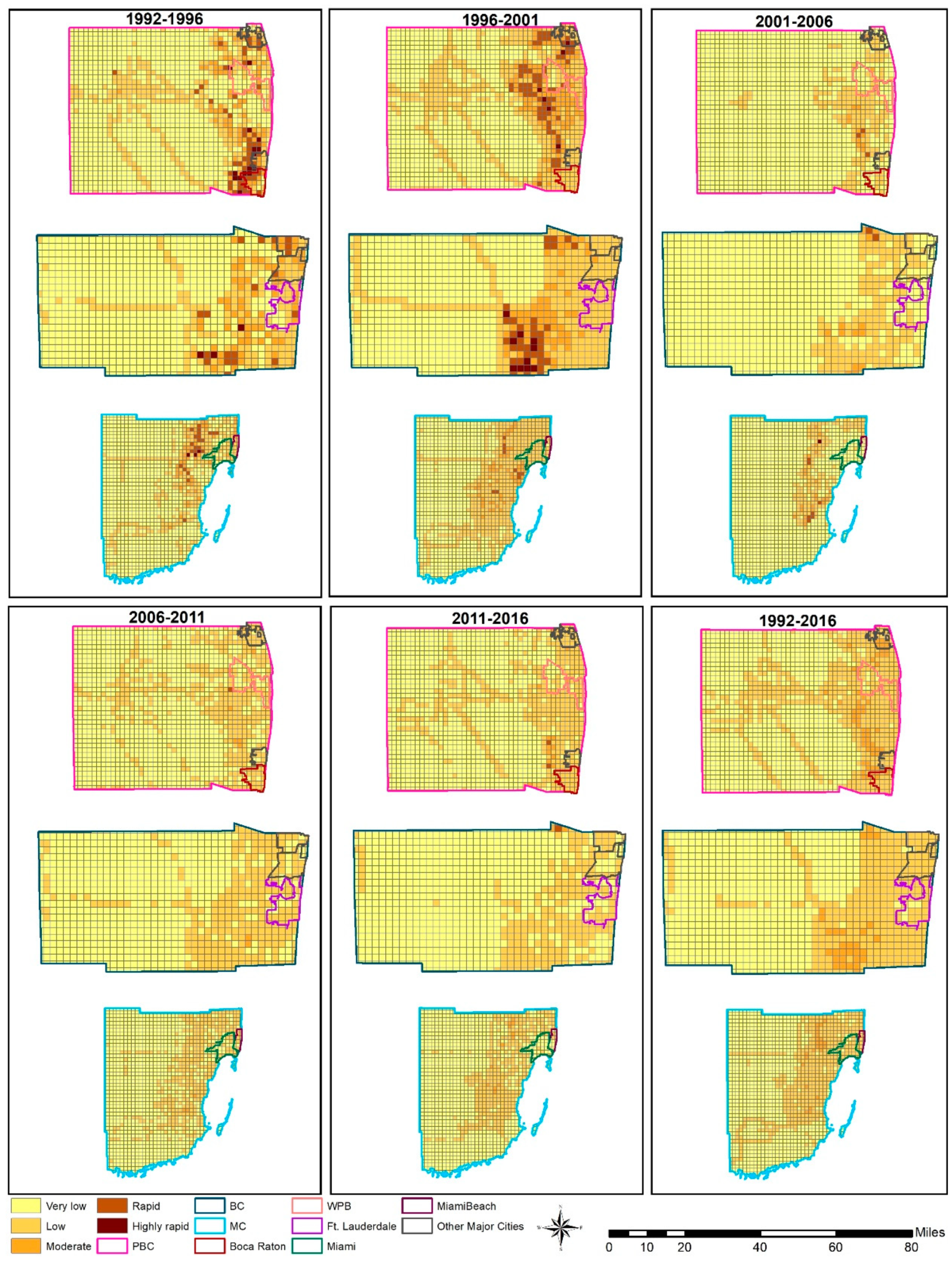




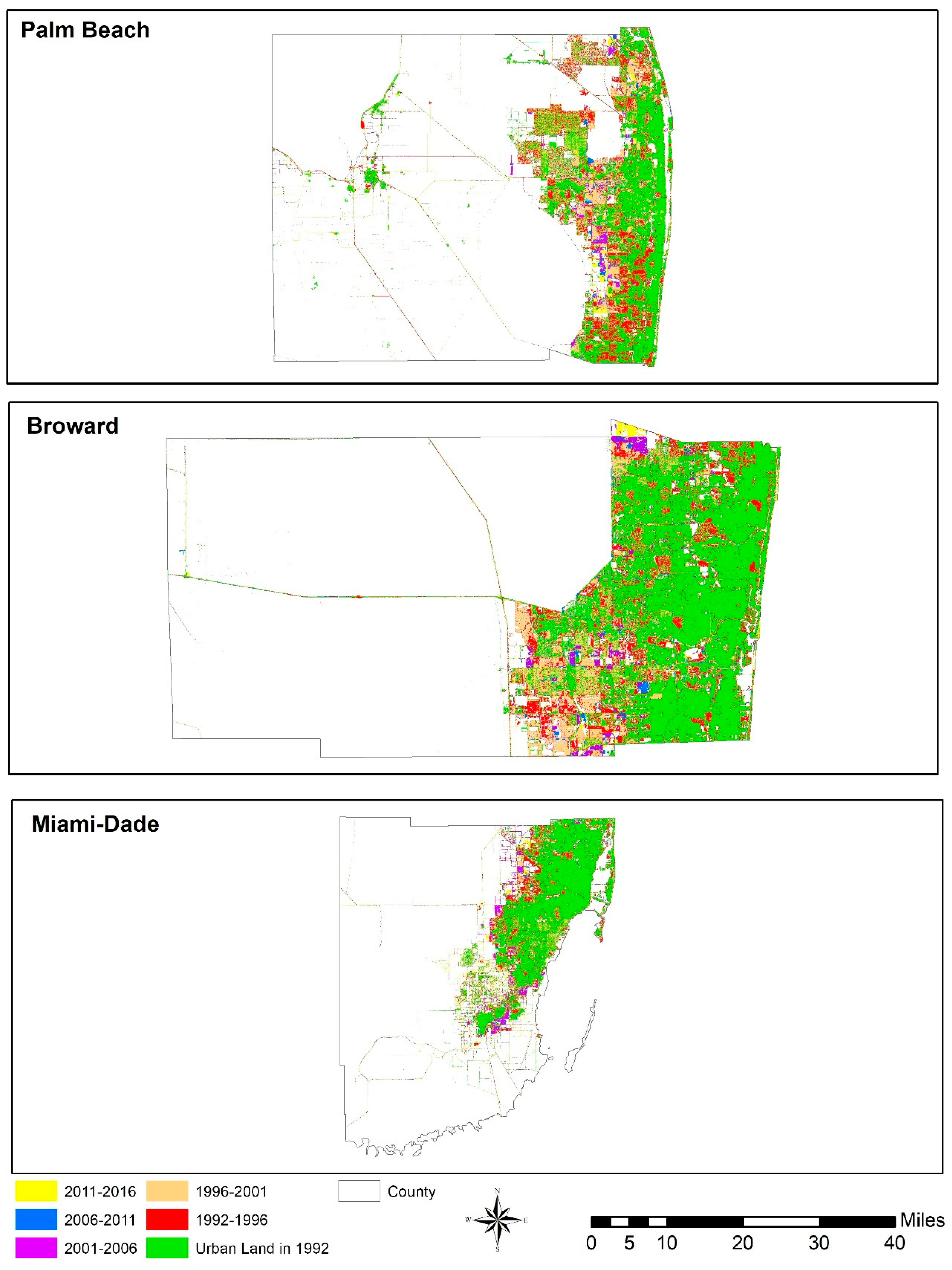
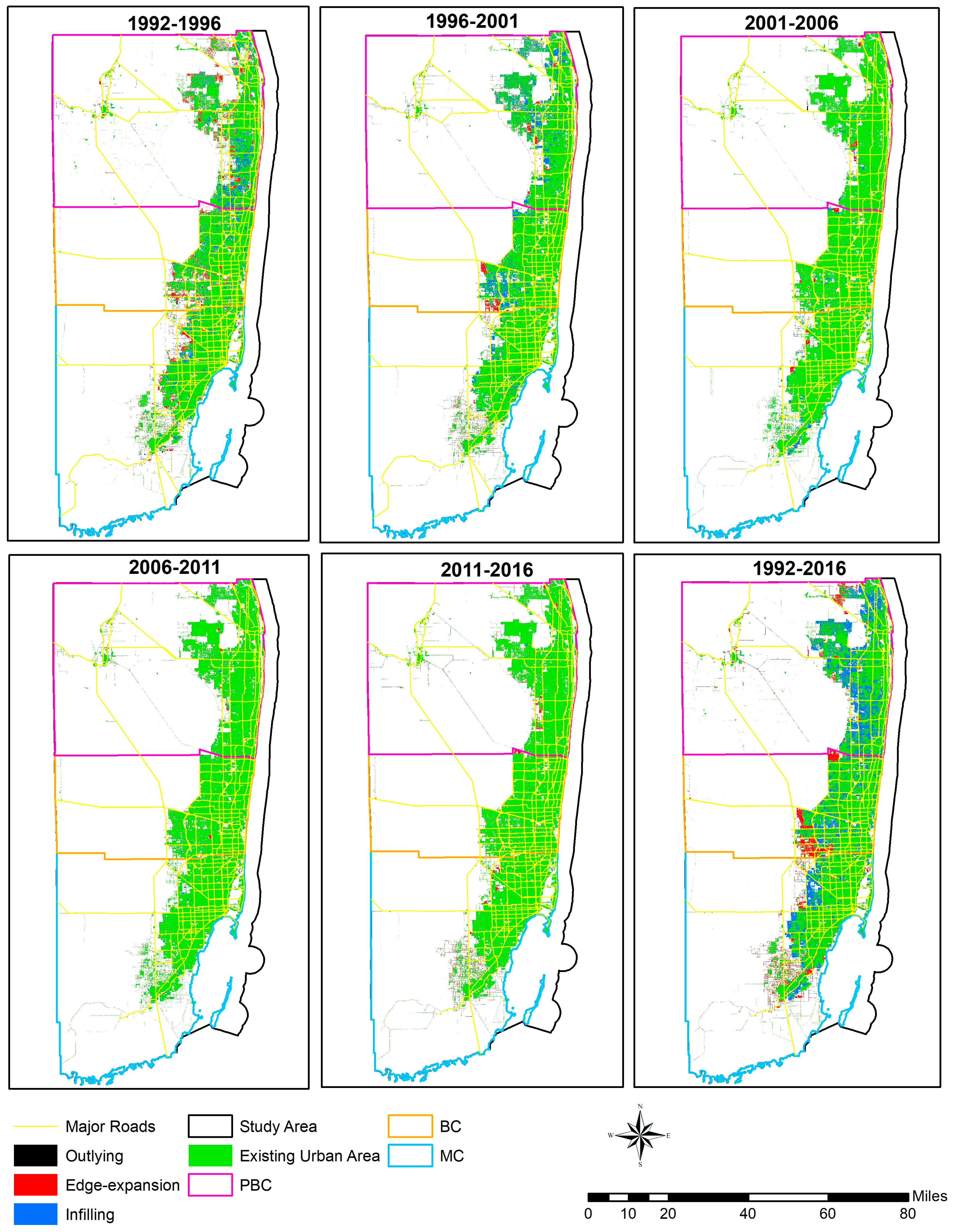
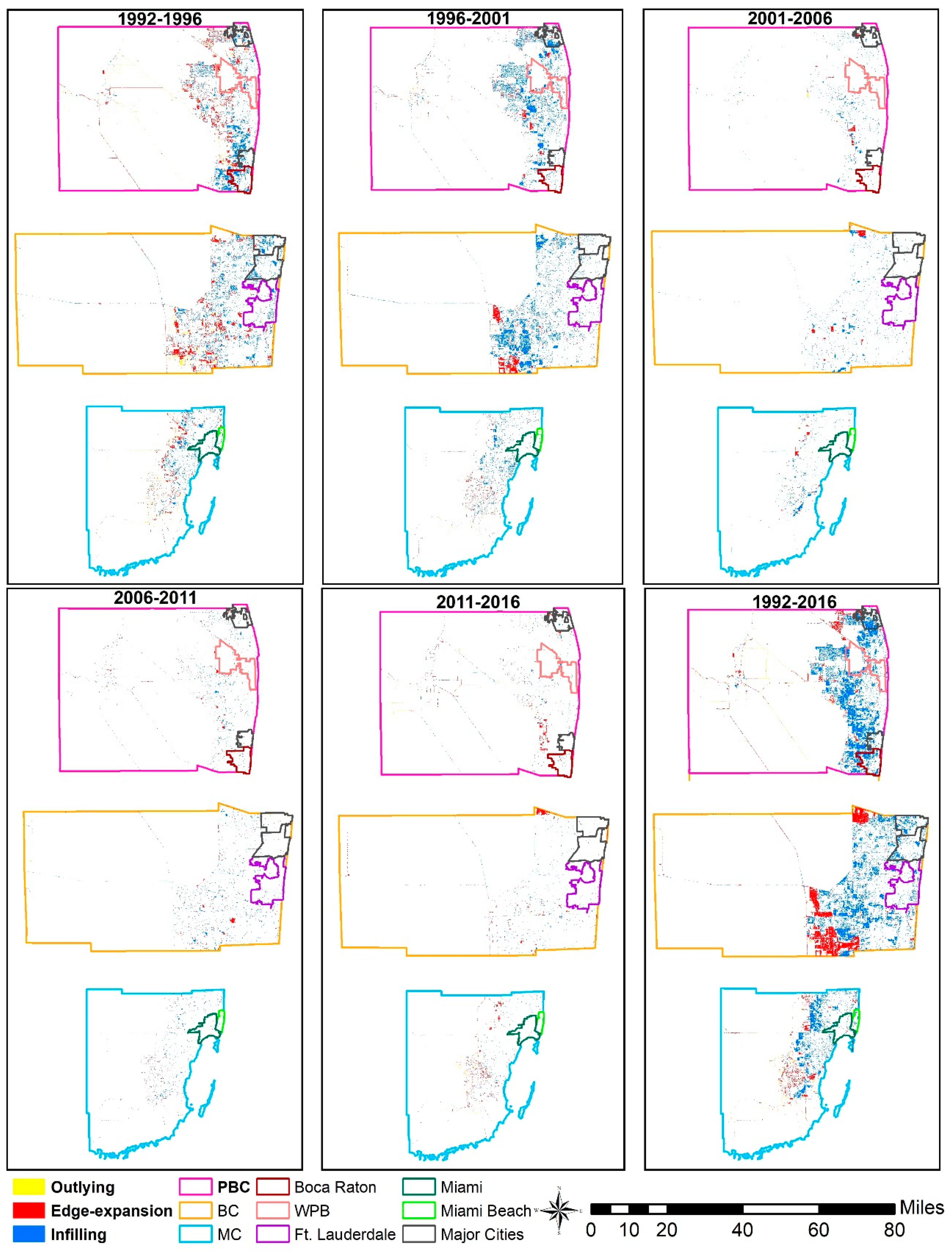
| Datasets | Classes in the Original Dataset | Classes Used to Define Urban Area in this Research | Overall Accuracy of the Datasets |
|---|---|---|---|
| NLCD (1992, 2001, 2006, 2011, 2016) | Open Water; Perennial Ice/Snow; Developed, Open Space; Developed, Low Density; Developed, Medium Density; Developed, High Density; Barren Land; Deciduous Forest; Evergreen Forest; Mixed Forest; Dwarf Scrub; Shrub/Scrub; Grassland/Herbaceous; Sedge/Herbaceous; Lichens; Moss; Pasture/Hay; Cultivated Crops; Woody Wetlands; Emergent Herbaceous Wetlands | Developed, Open Space; Developed, Low Density; Developed, Medium Density; Developed, High Density | ≥80% |
| C-CAP (1996) | Developed, High Intensity; Developed, Medium Intensity; Developed, Low Intensity; Developed, Open Space; Cultivated Crops; Pasture/Hay; Grassland/Herbaceous; Deciduous Forest; Evergreen Forest; Mixed Forest; Scrub/Shrub; Palustrine Forested Wetland; Palustrine Scrub/Shrub Wetland; Palustrine Emergent Wetland; Estuarine Forested Wetland; Estuarine Scrub/Shrub Wetland; Estuarine Emergent Wetland; Unconsolidated Shore; Bare Land; Open Water; Palustrine Aquatic Bed; Estuarine Aquatic Bed | Developed, High Intensity; Developed, Medium Intensity; Developed, Low Intensity; Developed, Open Space | ≥ 85% |
| Variable Category | Description | Variable | Sources |
|---|---|---|---|
| Socioeconomic factors | People (103 per km2) | Population | Population grid datasets from NASA’s Socioeconomic Data and Applications Center (SEDAC) website (https://sedac.ciesin.columbia.edu/data/collection/gpw-v4 and https://sedac.ciesin.columbia.edu/data/collection/grump-v1) for the year 1990, 1995, 2000, 2005, 2010, and 2015 as raster surface at 1 km resolution. |
| Median Household Income (103 per km2) | Median Income | Median household income data were derived at the block group level from National Historical GIS (NHGIS) website (https://www.nhgis.org/) [56] for the year 1990, 2000, 2010, 2011, and 2016 which were later converted to raster layers at 1 km resolution. | |
| Proximity factors | Distance to Major Roads (km) | Distance to Roads | Major road data for the years 2007, 2011, and 2016 were derived from TIGER/Line Shapefiles website (https://www.census.gov/geographies/mapping-files/time-series/geo/tiger-line-file.html) and for the year 1990, 1993, and 2000 were derived from Florida Geographic Data Library (FGDL) website (https://www.fgdl.org/metadataexplorer/about.html). Nearest distance to major roads for above years was calculated using the Euclidean Distance tool in ArcMap at a 1 km resolution. |
| Distance to Coastal Boundary (km) | Distance to Coast | Coastal boundary data were derived from the TIGER/Line Shapefiles website (https://www.census.gov/geographies/mapping-files/time-series/geo/tiger-line-file.html) for the year 2013 and 2016. Nearest distance to coastline was calculated using the Euclidean Distance tool in ArcMap at a 1 km resolution. | |
| Physical factors | Elevation (km) | DEM | Digital Elevation Data at 30 m resolution were derived from USGS National Elevation Dataset (https://catalog.data.gov/dataset/usgs-national-elevation-dataset-ned) and calculated using the Zonal Statistics tool in ArcMap at 1 km resolution. |
| Landscape Metric | Abbreviation | Description | Range |
|---|---|---|---|
| Number of Patches | NP | Total number of urban land cover patches surrounded by non-urban land cover types | NP ≥ 0 |
| Largest Patch Index | LPI | The proportion of total area occupied by the largest patch of a land cover type | 0 < LPI ≤ 100 |
| Landscape Shape Index | LSI | A modified perimeter-area ratio of the form that measures the shape complexity of the urban land cover type | LSI > 0 |
| Area-weighted Mean Shape Index | SHAP_AM | The shape index weighted by relative patch area which measures the average shape complexity of individual patches for the urban land cover type | SHAP_AM > 0 |
| 1992–1996 | 1996–2001 | 2001–2006 | 2006–2011 | 2011–2016 | 1992–2016 | |||||||
|---|---|---|---|---|---|---|---|---|---|---|---|---|
| AUEa | AUEs | AUEa | AUEs | AUEa | AUEs | AUEa | AUEs | AUEa | AUEs | AUEa | AUEs | |
| Miami-MSA | 45.7 | 1.92 | 96.57 | 3.61 | 18.41 | 0.61 | 8.91 | 0.29 | 11.45 | 0.37 | 34.38 | 1.27 |
| PBC | 23.64 | 2.90 | 48.39 | 5.01 | 5.89 | 0.52 | 3.56 | 0.31 | 4.02 | 0.34 | 16.15 | 1.68 |
| BC | 12.31 | 1.71 | 27.28 | 3.40 | 4.21 | 0.47 | 2.35 | 0.26 | 1.72 | 0.19 | 9.08 | 1.13 |
| MC | 9.63 | 1.14 | 20.82 | 2.29 | 8.34 | 0.84 | 2.96 | 0.29 | 5.38 | 0.52 | 9.04 | 0.97 |
| 1992 Model | Population | Distance to Coast | Distance to Roads | Adjusted R2 | |
| r | 0.691 | −0.605 | −0.409 | 0.605 | |
| S-coefficient | 0.521 | −0.360 | −0.065 | ||
| 1996 Model | Population | Distance to Coast | Distance to Roads | ||
| r | 0.681 | −0.578 | −0.319 | 0.590 | |
| S-coefficient | 0.522 | −0.360 | −0.084 | ||
| 2001 Model | Population | Distance to Coast | Distance to Roads | Median Income | Adjusted R2 |
| r | 0.606 | −0.587 | −0.367 | 0.106 | 0.538 |
| S-coefficient | 0.438 | −0.365 | −0.132 | 0.095 | |
| 2006 Model | Population | Distance to Coast | Distance to Roads | Median Income | Adjusted R2 |
| r | 0.611 | −0.599 | −0.376 | 0.144 | 0.560 |
| S-coefficient | 0.436 | −0.376 | −0.137 | 0.124 | |
| 2011 Model | Population | Distance to Coast | Distance to Roads | Median Income | Adjusted R2 |
| r | 0.611 | −0.602 | −0.379 | 0.162 | 0.564 |
| S-coefficient | 0.434 | −0.374 | −0.139 | 0.130 | |
| 2016 Model | Distance to Coast | Population | Distance to Roads | Adjusted R2 | |
| r | −0.617 | 0.596 | −0.412 | 0.554 | |
| S-coefficient | −0.422 | 0.381 | −0.161 |
© 2019 by the authors. Licensee MDPI, Basel, Switzerland. This article is an open access article distributed under the terms and conditions of the Creative Commons Attribution (CC BY) license (http://creativecommons.org/licenses/by/4.0/).
Share and Cite
Rifat, S.A.A.; Liu, W. Quantifying Spatiotemporal Patterns and Major Explanatory Factors of Urban Expansion in Miami Metropolitan Area During 1992–2016. Remote Sens. 2019, 11, 2493. https://doi.org/10.3390/rs11212493
Rifat SAA, Liu W. Quantifying Spatiotemporal Patterns and Major Explanatory Factors of Urban Expansion in Miami Metropolitan Area During 1992–2016. Remote Sensing. 2019; 11(21):2493. https://doi.org/10.3390/rs11212493
Chicago/Turabian StyleRifat, Shaikh Abdullah Al, and Weibo Liu. 2019. "Quantifying Spatiotemporal Patterns and Major Explanatory Factors of Urban Expansion in Miami Metropolitan Area During 1992–2016" Remote Sensing 11, no. 21: 2493. https://doi.org/10.3390/rs11212493
APA StyleRifat, S. A. A., & Liu, W. (2019). Quantifying Spatiotemporal Patterns and Major Explanatory Factors of Urban Expansion in Miami Metropolitan Area During 1992–2016. Remote Sensing, 11(21), 2493. https://doi.org/10.3390/rs11212493




